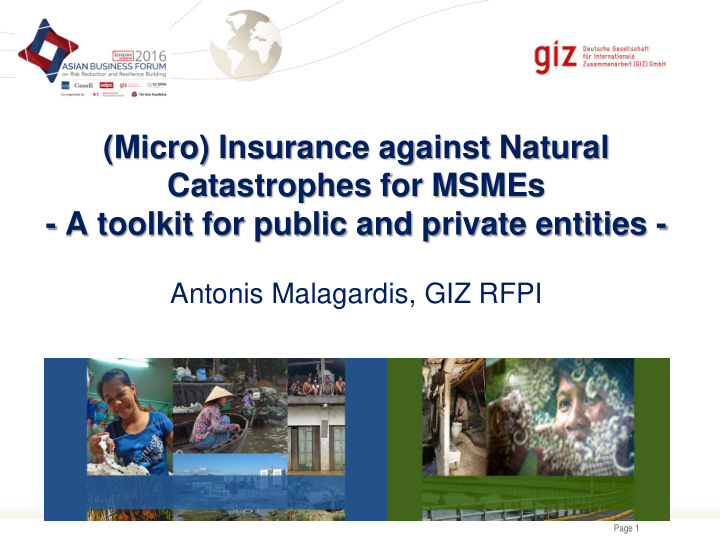



(Micro) Insurance against Natural Catastrophes for MSMEs - A toolkit for public and private entities - Antonis Malagardis, GIZ RFPI Page 1
Outline 1. Microinsurance works! 2. The response of MI to Typhoon Haiyan 3. SMEs and insurance 4. A diagnostic Toolkit for SMEs and NatCat Insurance 5. Next steps for public and private entities Page 2
RFPI GIZ ongoing work… Analysis of MI & NatCat Findings from MSMEs insurance needs assessment Implementation of a diagnostic toolkit for insurance against NatCat for SMEs Introduce MEFIN network 24/04/2016 APEC SME Finance Forum Page 3
Microinsurance works! Insurance Coverage 2014 Traditional Insurance Microinsur 28% ance 62% Source: Insurance Commission Philippines Page 4
MICROINSURANCE FIGURES WORLDWIDE (source: MI Landscape 2012,2013, 2014) MICR Page 5
Wall Street Journal 2013 www.microinsurancenetwork.org Page 6
Claims paid after the typhoon www.microinsurancenetwork.org Page 7
Findings… Business continuity is threatened by financial risk events T op 5 financial risks of MSMEs in the Philippines • 1 Natural Disasters (flood, heavy rain, drought, earthquake) • 2 Fire (affecting building or assets) Ranking • 3 Illness (of owner, employees or their family) • Theft • 4 Loss of potential income due to several reasons (supplier did not deliver raw materials on time, reservations and bookings got cancelled, etc.) • 5 Accidents causing injury or disability Source: Report Insurance Needs Assessment for MSMEs in the Philippines, GIZ, November 2014 24/04/2016 Page 8
Findings… Insurance tops the list of coping mechanisms of MSMEs to ensure business continuity 12 10 Number of respondents 8 6 4 2 0 Reduce Expenses Support from social Loan from Banking Increase of working Insurance Savings environment Institutions hours Source: Report Insurance Needs Assessment for MSMEs in the Philippines, GIZ, November 2014 24/04/2016 Page 9
Findings… Insurance tops the list of contingency plans of MSMEs to ensure business continuity Insurance Savings Installment of security measures Change of business location No contingency plan Frequent evaluation of short-term plans Engage in other line of business Alternative Marketing Other investments Re-staffing Storing lumber in three different locations Gov't (DA) tie-up to increase volume supplies 0 2 4 6 8 10 12 14 16 18 Number of respondents Source: Report Insurance Needs Assessment for MSMEs in the Philippines, GIZ, November 2014 24/04/2016 Page 10
Findings… MSMEs spoke of most relevant insurance products which would manage the threat of business continuity • Health, Hospitalization Life • Life, Memorial • Personal accident • Fire Property • Theft • Natural catastrophes • Performance bonds Liability • Loss of income • Cancellation of order/booking Source: Report Insurance Needs Assessment for MSMEs in the Philippines, GIZ, November 2014 24/04/2016 Page 11
1. Context of the Toolkit development Page 12
Diagnostic Toolkit structure: Analytical Framework Disaster Exploration Risk Risk Identification of DRM Assessment of Gaps Management options Mapping (insurance) 24/04/2016 Page 13
2. Highlights of the Toolkit Concept Page 14
International Risk Assessment Frameworks Analyze hazards Commonalities of the frameworks Identify exposures applied to MSMEs Assess susceptibility Estimate impacts Based on OECD 2012, IFAD 2015, WB 2012 Page 15
Insurance as a DRM option • Identify DRM tools that • a) achieve highest protective effectiveness • b) strengthen government’s and MSME’s resilience • c) meet the diversified needs of the MSME value chain • In a risk layering approach, the catastrophic risk layer (low frequency – high severity events) is where insurance can play a key role, transferring risks to third parties (e.g. insurance and re-insurance). …Integrated Insurance Approach… Page 16
Disaster Risk Exploration of Risk Identification of Management DRM options Assessment Gaps Mapping (insurance) Inventory of DRM Analyze hazards Strategies Prevention and Scope for Reduction Scope & Identify exposures Insurance? Characteristics of Strat. Assess susceptibility Mitigation Performance Analysis In line with an Estimate impacts Integrated Risk Mgmt. Approach Matching of Risks and Strat. Coping Evaluate risks Institutional Arrangements Regulation and Supervision Page 17
For further discussion & Homework Application/ Use of the Toolkit : • Governments re integrated disaster risk management approaches • Is the information to be assessed through the AF useful (too much information – lack of information)? • Is the process feasible/realistic (considering funding and time constraints, incl. human resources)? • Insurance industry in the development of NatCat insurance products • Are the information assessed useful (too much information – lack of information)? • Would this information motivate you to enter the (index) NatCat market for MSMEs (also for meso and macro level products)? • What other conditions would encourage you to enter the NatCat market? Page 18
Page 19
THANK YOU VERY MUCH FOR YOUR ATTENTION For downloading the Diagnostic toolkit: http://www.inclusiveinsuranceasia.com/docs/Toolkit_Publication_Final.pdf www.inclusiveinsuranceasia.com Antonis.malagardis@giz.de Page 20
Recommend
More recommend